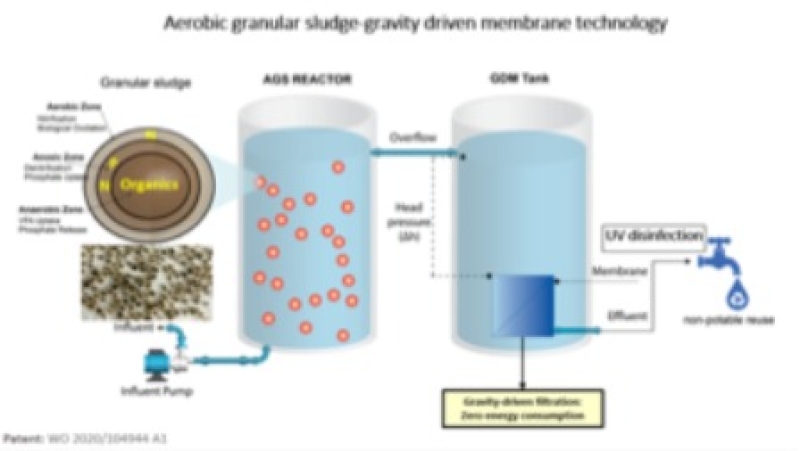- UNRWA Situation Report on Crisis in Gaza & Occupied West Bank |
- Intimidation or bloodshed cannot halt Bangladesh’s march to democracy |
- Khaleda Zia integral to an important chapter in BD history: Yunus |
- Enthusiasm marks Victory Day celebrations across Bangladesh |
- Dhaka-Delhi ties deep; to be shaped by trust, dignity, mutual respect |
Seed Funding Secured Fof Saudi Wastewater Sludge Treatment

Wastewater sludge treatment technology
Saudi-Arabian wastewater treatment start-up NuRain has secured €555,000 Seed Funding that will be used to build local technical and commercial capabilities as the company seeks to scale its sludge reduction technology to commercial projects.
Who led the funding round?
The funding round was led by Kaust (King Abdullah University of Science and Technology) Innovation Ventures (KIV). Writing on LinkedIn, KIV congratulated NuRain on closing the funding round, adding that the company is 'is leading the way in advanced water reuse technologies, offering a groundbreaking solution that aligns with the Kingdom's National Water Strategy 2030'.
What will the funding be used for?
Wayne Byrne, NuRain executive chairman, told Aquatech Online: "The funding will be used to build a local technical and commercial capability, to win NuRain's first commercial project."
The funding will help the company move to the next stage of its development. This involves commercialising the AGS-GDM technology by securing its first major deployment in Saudi Arabia.
Byrne added: "NuRain also aims to continue optimising the technology through further research and scaling its deployment capabilities. Additionally, the team will focus on establishing strategic partnerships with governmental and industrial clients, setting the foundation for larger-scale operations and international expansion."
How is the NuRain technology different from other solutions?
NuRain's AGS-GDM technology combines Aerobic Granular Sludge (AGS) with Gravity-Driven Membrane (GDM) filtration in a single, compact system.
Unlike conventional Activated Sludge (CAS) systems, which are energy-intensive and produce large amounts of sludge, NuRain's technology reduces energy use by 75+ per cent and sludge production by 60+ per cent. It also provides superior removal of key contaminants - organics, nitrogen, and phosphorus - achieving reuse water quality standards that are suitable for non-potable applications like irrigation and industrial processes.
Byrne told Aquatech Online that: "The integration of AGS and GDM is unprecedented, enabling the system to operate efficiently in decentralised locations, making it ideal for remote communities and small to medium-scale developments."
How does the technology work?
The AGS-GDM system uses the properties of aerobic granular sludge for effective biodegradation, removing organic contaminants and nutrients like nitrogen and phosphorus.
The GDM component filters the treated water through gravity, minimising energy consumption.
"The technology operates in a compact, fully automated setup, providing high-quality treated water suitable for non-potable reuse, such as agricultural irrigation, at ultra-low operational costs," Byrne explained.
The high efficiency in energy consumption, nutrient removal, and bio-sludge production is achieved through NuRain's proprietary design, which enables a flexible AGS process that results in significant sludge reduction, energy optimisation (energy consumption as low as 0.05 kWh/m³), and high enrichment of key microorganisms responsible for the removal of ammonium and phosphate.
Byrne added: "Our innovative approach of integrating AGS with GDM allow us to achieve premium quality effluent suitable for various non-potable reuse applications and at a significantly reduced operational and maintenance costs compared to the aerobic membrane bioreactor (AeMBR) technology, which is the gold standard for wastewater treatment and reuse."
The GDM unit employs microfiltration/ultrafiltration (MF/UF) with a nominal pore size of 0.4 micrometres or smaller, providing highly effective removal of microbial and chemical pollutants. Operating via gravity, the system is energy-efficient while maintaining consistent effluent quality with NTU < 1, TSS < 1, and faecal and total coliform falling below detection limits.
Where has the technology been trialled?
The technology was successfully trialled at scale (100 m³/day) in Saudi Arabia at the Rabigh Wastewater Treatment Plant (WWTP) in partnership with the National Water Company (NWC).
"Over the last two years we have validated the system's ability to treat sewage from urban sources to produce high-quality, reuse-standard water," Byrne added.
Byrne told Aquatech Online that a number of key lessons were learnt from the full-scale, these included the optimisation of process parameters for maximum nutrient removal and further fine-tuning the GDM component to ensure low energy consumption while maintaining high filtration efficiency.
While the primary focus of the trial was validating the AGS-GDM technology independently, the trials included benchmarking the NuRain technology against conventional Activated Sludge (CAS) systems and Membrane Bioreactors (MBR).
According to the company, these comparisons demonstrated NuRain's advantages in terms of energy efficiency, sludge reduction, and water quality. - Aqua Tech Newsletter

